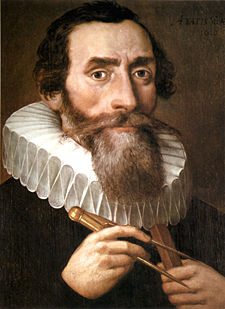[/caption]
“The square of the orbital period of a planet is proportional to the cube of the semi-major axis of its orbit” That’s Kepler’s third law. In other words, if you square the ‘year’ of each planet, and divide it by the cube of its distance to the Sun, you get the same number, for all planets.
(The other two are “the orbit of each planet is an ellipse with the Sun at a focus”, and “a line between a planet and the Sun sweeps out equal areas in equal times”.)
Copernicus, Kepler, and Newton dealt a one-two-three knockout blow to the idea – thousands of years old – that the Sun (and planets) moved around the Earth. Copernicus put the Sun at the center, Kepler modified Copernicus’ circular motions (and provided a simple, quantitative description of the actual motion), and Newton explained how it all worked (gravity).
Kepler worked out his three laws from detailed records of observations of the positions of the planets (known at the time, Mercury, Venus, Mars, Jupiter, and Saturn) – especially Mars – painstakingly compiled by Tycho Brahe.
Kepler’s third law (in fact, all three) works not only for the planets in our solar system, but also for the moons of all planets, dwarf planets and asteroids, satellites going round the Earth, etc. Well, not quite; if the secondary body – a planet, say – has a mass that’s a significant fraction of the primary one (the Sun, say), then the law needs a small tweak.
By showing how Kepler’s laws could be derived from his universal law of gravitation, Newton united heaven and earth, perhaps the greatest revolution in science (OK, Darwin’s revolution may be greater). Before Newton, the heavens were thought to work according to rules quite different from the ones which governed things on Earth.
NASA’s Imagine the Universe! has a neat demonstration of Kepler’s laws, and this PDF file (from the University of Tennessee Knoxville’s Maths Department) gives a simple derivation of Kepler’s laws, from Newton’s universal law of gravitation.
Universe Today articles with more information: Kepler’s Laws, Let’s Study Law: Kepler Would Be So Proud, and Happy Birthday Johannes Kepler.
Gravity, an Astronomy Cast episode, also discusses Kepler’s third law, as does Where is the Center of the Universe?.

